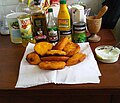Top Qs
Timeline
Chat
Perspective
Venezuelan cuisine
Culinary traditions of Venezuela From Wikipedia, the free encyclopedia
Remove ads
Venezuelan cuisine is influenced by its European[1] (Italian, Spanish, Portuguese, German, and French), West African, and indigenous traditions. Venezuelan cuisine varies greatly from one region to another. Food staples include corn, rice, plantains, yams, beans and several meats.[1][2][3]
This article needs additional citations for verification. (June 2015) |
Potatoes, tomatoes, onions, eggplants, squashes, spinach and zucchini are also common side dishes in the Venezuelan diet. Ají dulce and papelón are found in most recipes. Worcestershire sauce is also used frequently in stews. Venezuela is also known for having a large variety of white cheese (queso blanco), usually named by geographical region. Italian settlers contributed pasta and meat products, while German settlers introduced Berliners (which are locally called bomba) and kuchens.
Venezuelans have three main meals: a large breakfast, a large dinner (around noontime), and a very light supper in the evening. Venezuelan hospitality is widespread, so something to drink and eat is expected when visiting someone's home. Arepas, the most distinctive Venezuelan food, are thick disks made of precooked cornmeal, either fried or baked. Large arepas, with a variety of fillings (ham and cheese is the most popular one), are eaten as snacks throughout the day; smaller arepas are typically served as side companions at all meals.[citation needed]
Remove ads
Main dishes
Remove ads
Typical snacks
Remove ads
Beverages

- Beer[1]
- Catara sauce – an alleged aphrodisiac based on juice of cassava
- Chicha [1] – non-alcoholic drink, made of boiled white rice, milk and sugar
- Cocada – Coconut milkshake, found mostly in coastal areas
- Papaya juice
- Mango juice
- Passion fruit juice
- Malta – Non-alcoholic carbonated malt
- Papelón con limón [1]
- Ponche crema – Served especially during Christmas season
- Venezuelan rum[1]
- Frescolita (strawberry-flavored soda)
- Chinotto (the counterpart to Sprite or Seven Up)
- Cocuy[1] – Similar to Tequila. Served at celebrations.
- Guayoyo – Slightly watered down black coffee, commonly served after meals
Breads
- Casabe – cassava flatbread
- Pan dulce – Spanish for "sweet bread"
- Pan de jamón – usually filled with ham, olives, and raisins and usually eaten during the Christmas season
Desserts

- Alfajor – maize cookie with arequipe and grated coconut
- Bienmesabe - sweet Spanish dessert prepared with honey, egg yolk, and ground almonds as primary ingredients
- Brazo gitano (the Spanish Swiss roll)
- Conserva de guayaba – Guava confection
- Chupichupi – a water-based frozen snack in a plastic tube, a freezie
- Dulce de lechosa – Green papaya slowed cooked in a syrup flavored with cinnamon, cloves, and vanilla
- Cascos de guayaba
- Cucas – cookies with brown sugar also called catalinas
- Golfeado
- Masamorra
- Majarete
- Mousse de chocolate
- Naiboa
- Negro en Camisa - Dark Chocolate Cake
- Pudín de chocolate – chocolate pudding
- Quesillo – local style caramel flan
- Papitas de leche - Traditional sweet treats or Milk Truffles
- Panelas de San Joaquin – biscuits twice baked recipe flavored with anis seed from San Joaquin, Carabobo State
- Polvorosas – butter cookies with cinnamon
- Paledonias – cookies with brown sugar also called cucas or catalinas
Remove ads
Cheese

Queso blanco is very popular in Venezuela. It is produced all over Venezuela with different flavors and textures. The name of each variety of cheese is usually related to the geographical region.
- Cuajada andina
- Llanero cheese
- Queso blanco duro
- Queso de año
- Queso de mano
- Queso crineja
- Guayanés cheese
- Paisa cheese
- Palmita cheese
- Palmizulia cheese
- Telita cheese
See also
References
External links
Wikiwand - on
Seamless Wikipedia browsing. On steroids.
Remove ads























